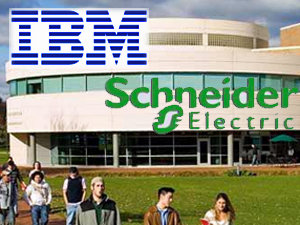IBM, Schneider Electric Team Up to Make Buildings Smarter
<p>IBM and Schneider Electric are joining forces to provide new smarter buildings solutions that combine robust data collection and powerful analytics, enabling owners to better manage energy use at their facilities and obtain greater savings. The partnership was one several announcements about new offerings, software, services and tools from IBM in its Smarter Planet campaign.<br /> </p>

IBM and Schneider Electric are joining forces to provide new smarter buildings solutions that combine robust data collection and powerful analytics, enabling owners to better manage energy use at their facilities and obtain greater savings.
The partnership with Schneider, an expansion of a longstanding relationship, was among the major developments unveiled by IBM's Al Zollar today at the West Coast Green conference in San Francisco.
The new offerings of software, services and tools, which were developed in house and in concert with many of IBM's strategic partners, represent the latest wave of developments to emerge from Big Blue's Smarter Planet campaign. The company lifted the veil on other partnerships this spring at its Pulse 2010 conference.
IBM's strategy has been to team up with other leading businesses, harness their capabilities, integrate them and apply IBM's analytic might to produce end-to-end sustainability solutions for smarter connected buildings, grids, communities, transportation and infrastructure systems.
"This is not about IBM," said Zollar, the general manager for Tivoli software in IBM's Sustainable Enterprises and the Smart Urban Infrastructure unit. "It takes an ecosystem of organizations ... we really believe that working together we can create a smarter planet "
The news today included the addition of Autodesk to IBM's Green Sigma Coalition, which brings the design software developer into the group of big-name companies whose products support energy efficiency, management of water use and consumption of other resources, and reduction of greenhouse gas emissions and waste.
Zollar in his presentation and other company executives in interviews this week detailed further developments that stemmed from Green Sigma alliances and technology developed in-house. They include:
Technology called the Smarter Building solution. IBM is installing its first "customer-ready" end-to-end Smarter Building solution at it headquarters in Armonk, NY, and at a manufacturing facility in Rochester, Minn. The solution was implemented with Johnson Controls Inc. and connects information from the building management system, electrical meters, the IBM Maximo asset management system, weather data and other external information. Using advanced analytics, the solution provides new and deeper information about energy consumption, operations and space usage.
The system is geared toward delivering information that yields more than basic energy and cost savings and helps users make better decisions about how to operate their facilities and manage their business. The solution features a dashboard based on the IBM Mashup Center and provides a real-time view information culled and analyzed by the system.
The Smarter Building solution is designed to mesh well with building management systems available from Johnson Controls, Tridium, Schneider Electric and other leading controls companies.
A new version of IBM Maximo Asset Management for Energy Optimization. A highly visual tool, version 7.1.1 collects and displays a data center's energy and environmental data including temperature, humidity and power usage, and generates a thermal map of the environment. The graphics show users where there are opportunities to save energy and help identify potential issues before they become problems.
A services offering called the IBM Sustainability Management System, which is based on the company's best practices, helps users integrate and align sustainability efforts with business strategies.
An online tool called MyIncentiveFinder, www.ibm.com/green/myincentivefinder, which the company developed with the North Carolina Solar Center at North Carolina State University. The tool helps identify and estimate incentives related energy projects, tax credits and more.
A project with Green Sigma coalition charter member Johnson Controls Inc. that helped Ave Maria University in Florida save $1 million in building costs and $350 million a year in combined operating costs by converging 23 systems into a single IP and integrating Johnson Control's Metasys automation and control system with IBM's Maximo asset management software.
Work with the Eaton Corporation and North Carolina State University to create a smarter buildings solution demo project at the Future Renewable Electric Energy Delivery and Management (FREEDM) Systems Center in Raleigh, NC. FREEDM is an engineering research center funded by the National Science Foundation.
The biggest news of the day was the partnership between IBM and Schneider Electric on solutions development. Schneider is one of several leading firms in the control systems and integration business that are charter members of Green Sigma coalition, Johnson Controls and Honeywell among them.
"I think that all three of these companies have capabilities that are very complementary to IBM's, and would expect all of them to be engaged in various bi-lateral and multi-lateral customer engagements," said Christopher Mines, senior vice president of Forrester Research Inc. and a guest writer for GreenBiz.com. "Because of Schneider's data center expertise (via its APC subsidiary), it's the closest to IBM's home turf and so not too surprising that they would be earlier."
Word of the partnership capped a sheaf of announcements this week from Schneider, which unleashed an array of products and tools aimed at better systems management in the built environment. (Managing Editor Matthew Wheeland's news article and analysis are available at GreenBiz.com.)
"Schneider has had a long-term relationship with IBM in terms of selling to them, with them and through them in the data center space," said Chris Davis, the vice president for Global Strategic Alliances in Schneider Electric's Buildings Business.
Extending the relationship into the buildings business is a natural progression, he said, given that the two companies have a "very complementary set of core competencies."
Working with data centers has given Schneider extensive experience with technology that can provide a spectrum of drill-down data for operations that require continuous, precise measurements of countless activities.
Marrying technology from the two firms is expected to produce an information-rich systems powerhouse of data collection, advanced analytics and real-time feedback for use beyond the data center and single buildings to a company's entire portfolio.
Solutions that do so, said IBM Vice President of Energy and Environment Rich Lechner, "can change the behavior of individuals and organizations."
Such a system is already in place at Bryant University in Rhode Island, where the data center -- a long-time user of Schneider controls and IBM servers -- sought to build on the 15 percent in energy savings it had realized since opening a new facility in 2007.
The data center's initiative to achieve increased savings brought IBM and Schneider together to produce a solution -- the root of the partnership announced today. That solution is now being applied across the 50 buildings on the 428-acre campus said Rich Siedzik, director of Computer & Telecommunications Services at Bryant.
"We quickly saw the value proposition," said Siedzik. "And what we saw work inside the data center, prompted us to go to the facilities folks and demonstrate to them what we had."
Image in photo illustration courtesy of Bryant University.





